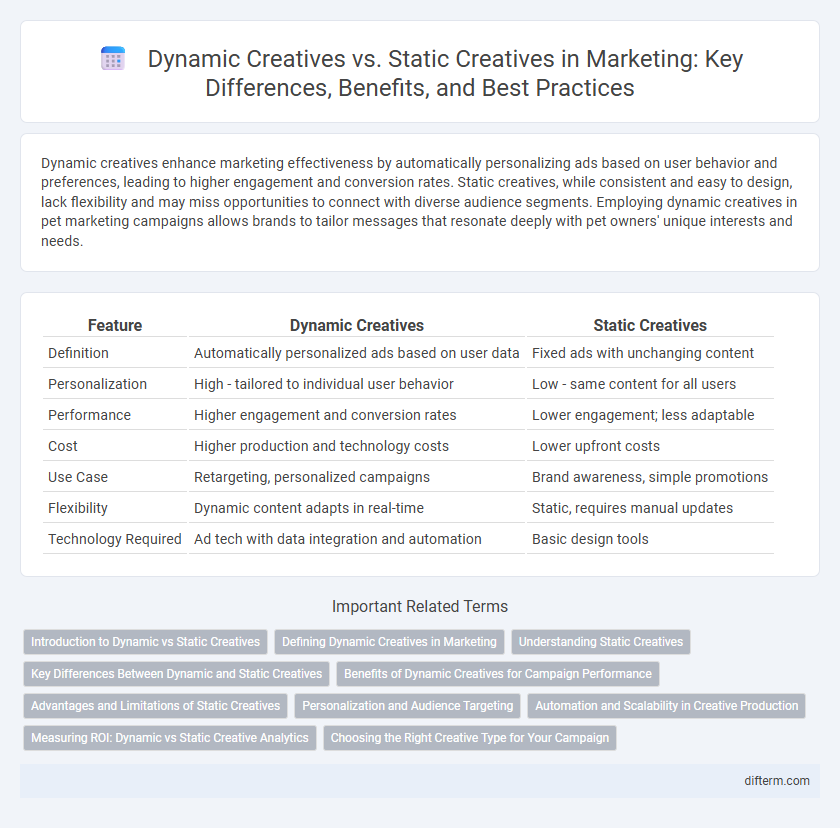Dynamic creatives enhance marketing effectiveness by automatically personalizing ads based on user behavior and preferences, leading to higher engagement and conversion rates. Static creatives, while consistent and easy to design, lack flexibility and may miss opportunities to connect with diverse audience segments. Employing dynamic creatives in pet marketing campaigns allows brands to tailor messages that resonate deeply with pet owners' unique interests and needs.
Table of Comparison
| Feature | Dynamic Creatives | Static Creatives |
|---|---|---|
| Definition | Automatically personalized ads based on user data | Fixed ads with unchanging content |
| Personalization | High - tailored to individual user behavior | Low - same content for all users |
| Performance | Higher engagement and conversion rates | Lower engagement; less adaptable |
| Cost | Higher production and technology costs | Lower upfront costs |
| Use Case | Retargeting, personalized campaigns | Brand awareness, simple promotions |
| Flexibility | Dynamic content adapts in real-time | Static, requires manual updates |
| Technology Required | Ad tech with data integration and automation | Basic design tools |
Introduction to Dynamic vs Static Creatives
Dynamic creatives use data-driven algorithms to tailor ad content in real-time, enhancing user engagement by delivering personalized messages. Static creatives feature fixed content that remains unchanged across all impressions, providing consistent branding but limited adaptability. Marketers leverage dynamic creatives to optimize campaign performance through responsive customization, whereas static creatives ensure brand consistency and simplicity in design implementation.
Defining Dynamic Creatives in Marketing
Dynamic creatives in marketing refer to advertisements that automatically adapt their content, visuals, or messaging based on user data, behavior, or context in real-time. These personalized ads increase engagement by delivering relevant experiences tailored to individual preferences, enhancing conversion rates and return on ad spend (ROAS). The use of dynamic creatives leverages machine learning algorithms and data integration platforms to optimize creative assets efficiently across multiple channels.
Understanding Static Creatives
Static creatives are fixed designs used in marketing campaigns that do not change or adapt based on user behavior or contextual data. These creatives often consist of images or text that remain constant across all impressions, making them easier to produce but less personalized. While static creatives may have lower engagement rates compared to dynamic creatives, they provide consistent brand messaging and can be effective for broad awareness campaigns.
Key Differences Between Dynamic and Static Creatives
Dynamic creatives automatically adjust content and visuals based on user data and behavior, enabling personalized and relevant ad experiences that boost engagement and conversion rates. Static creatives present fixed content and design, offering consistent messaging ideal for brand recognition and simple campaigns. The main differences lie in adaptability, customization, and performance measurement, with dynamic creatives leveraging real-time data for optimized targeting, while static creatives rely on predetermined, unchanging assets.
Benefits of Dynamic Creatives for Campaign Performance
Dynamic creatives adapt personalized content in real-time, enhancing audience engagement by delivering relevant ads tailored to individual preferences and behaviors. This approach increases click-through rates and conversion rates by optimizing messaging based on user data and contextual factors. Campaigns using dynamic creatives demonstrate improved ROI through better targeting efficiency and reduced ad fatigue compared to static creatives.
Advantages and Limitations of Static Creatives
Static creatives offer consistent brand messaging and quick load times, making them highly effective for reinforcing brand identity across platforms. They require less production time and lower costs compared to dynamic creatives, which is advantageous for campaigns with limited budgets or tight deadlines. However, static creatives lack personalization and real-time adaptability, limiting their potential to engage diverse audience segments or respond to changing user behavior.
Personalization and Audience Targeting
Dynamic creatives leverage real-time data to personalize ads for individual users, enhancing engagement by delivering relevant content based on user behavior and preferences. Static creatives offer fixed messaging without customization, limiting their effectiveness in reaching diverse audience segments. Utilizing dynamic creatives improves audience targeting by adapting messages to specific demographics, increasing conversion rates and ROI in marketing campaigns.
Automation and Scalability in Creative Production
Dynamic creatives leverage automation technologies such as AI-driven content generation and real-time data integration to deliver personalized ads at scale, significantly enhancing scalability compared to static creatives. This automated approach reduces manual workload and accelerates production cycles, enabling marketers to efficiently test and optimize numerous creative variations across multiple platforms. Static creatives, by contrast, require manual updates and lack the flexibility to adapt on-the-fly, limiting their scalability in fast-paced advertising environments.
Measuring ROI: Dynamic vs Static Creative Analytics
Dynamic creatives enable precise tracking of user interactions and adaptation based on real-time performance data, resulting in more accurate ROI measurement compared to static creatives. Static creatives provide limited analytics due to their unchanging nature, making it harder to attribute conversions and optimize campaigns. Advanced dynamic creative analytics utilize machine learning to continuously refine content delivery, significantly enhancing marketing efficiency and ROI accuracy.
Choosing the Right Creative Type for Your Campaign
Dynamic creatives leverage real-time data to tailor ads to individual user preferences, significantly boosting engagement and conversion rates. Static creatives offer a consistent and controlled brand message, ideal for campaigns targeting a specific audience with a fixed message. Selecting the right creative type depends on campaign goals, budget constraints, and audience behavior, with dynamic creatives excelling in personalization and static creatives providing brand consistency.
Dynamic creatives vs static creatives Infographic

 difterm.com
difterm.com